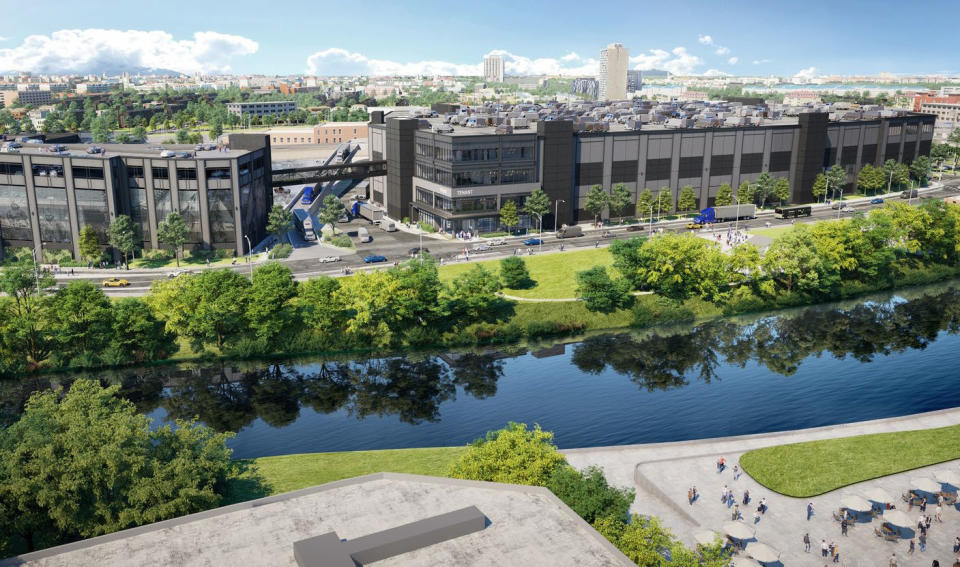The slow climb of multistory warehouses

Earlier this month, real estate services firm JLL Inc. published a report marking the fifth anniversary of the country’s first multistory logistics warehouse, a Prologis Inc. facility in the Georgetown Crossroads section of south Seattle. The report was titled “Multi-Story Warehouses and Their Towering Future.”
Clever wordsmithing aside, there is an open question today, as there was then, as to how much traction the multistory model will gain. New York City, with its dense urban population, a geography bordered by bodies of water that inherently block land expansion and extremely high real estate values, is the most active market for vertical construction. According to the JLL (NYSE: JLL) report, there are five multistory warehouses standing in New York City, with five more under construction.
Besides the Seattle complex, which is a 590,000-square-foot facility currently fully occupied by a large, unidentified retailer, Prologis (NYSE: PLD) owns and operates a multistory building in Miami.
The next step in the evolution will be in Chicago, a teeming metropolis bordered by one of the Great Lakes and thus land constrained to the north. The two-story facility, located on West Division Street in the city’s downtown, will boast 1.2 million square feet when it is completed sometime in 2024.
The JLL report, while acknowledging the multistory facility trend is still in its infancy, said the segment’s potential remains strong. The macro-factors appear to be in place. The U.S. population continues to grow. More Americans are filling the nation’s urban centers. E-commerce demand relentlessly marches on, pushing businesses to adopt more hyperlocal delivery solutions to rush orders to customers.
Markets like Atlanta, Houston and Dallas/Fort Worth, none of which are particularly land constrained, are candidates for multistory facilities, according to the report, which said other fertile markets include Miami and Seattle.
The multistory concept has been in place for decades in Asia and Europe, continents with countries that have relatively scarce available land. The American model calls for higher clearances than in Asia and Europe in order to handle bigger trucks. U.S. multistory buildings will likely be capped at two to three floors, unlike in Asia, where one facility, in Hong Kong, has 22 floors.
A difference between multistory and traditional mezzanine buildings is that each floor in a multistory facility has loading dock capabilities. Two-story multistory facilities can also do double duty for businesses looking to use one floor for fulfillment and another for distribution.
Though the demographics favor future growth, the economics — which were challenging in 2018 — have likely become even more so today. Relative to traditional one-story, squat warehouses, multistory facilities have higher costs and more challenging designs to execute. According to data published in late 2018 from real estate services firm CBRE Services, a two-story structure could cost about $150 per square foot more than a single-story facility because of higher material and construction costs that come with double decking. CBRE did not respond to a query to update its figures.
That differential was calculated during a period of benign inflation for labor and materials. Today’s gap would likely be much wider given the upward cost spiral during the pandemic and the supply chain bottlenecks that ensued. Although they have moderated over the past year, construction costs remain historically elevated.
The subsegment is also not immune from the spike in borrowing costs that have impacted all areas of real estate, including logistics warehousing, which is managing through a 10-year low in construction starts as investors back away from projects because of projected lower returns on their money.
One post-pandemic element that has yet to play out is to what extent low-rise office buildings, many of which have slack demand due to the work-from-home transition, might be suitable candidates for conversion to multistory warehouses.
Securing land, financing, materials and labor are short- to intermediate-term challenges for multistory projects. “You’re not building these in a month,” said Mehtab Randhawa, global head of industrial research at JLL.
Still, Randhawa remains bullish on the segment given the demographics, even though she acknowledges that multistory projects are “ultra-expensive” to build and not every market will have the profile to support multistory units.
The post The slow climb of multistory warehouses appeared first on FreightWaves.
